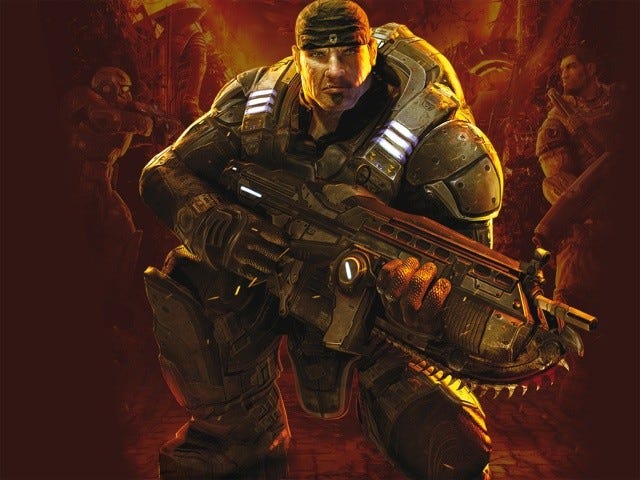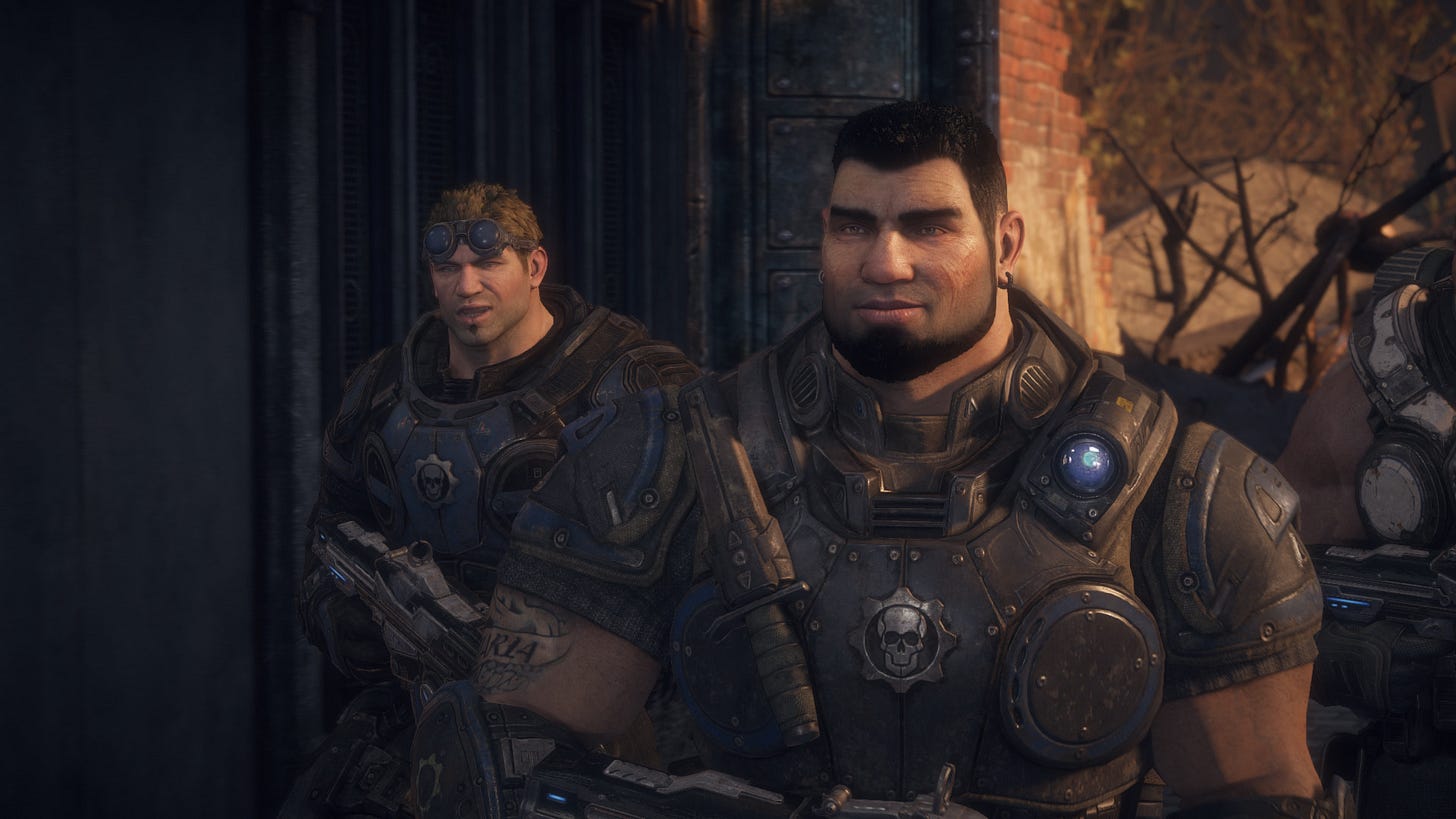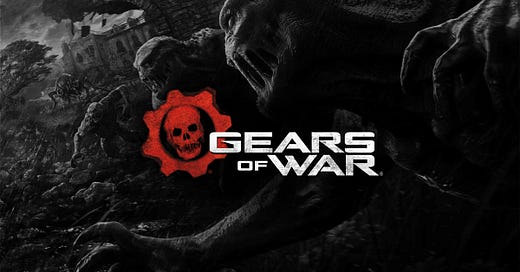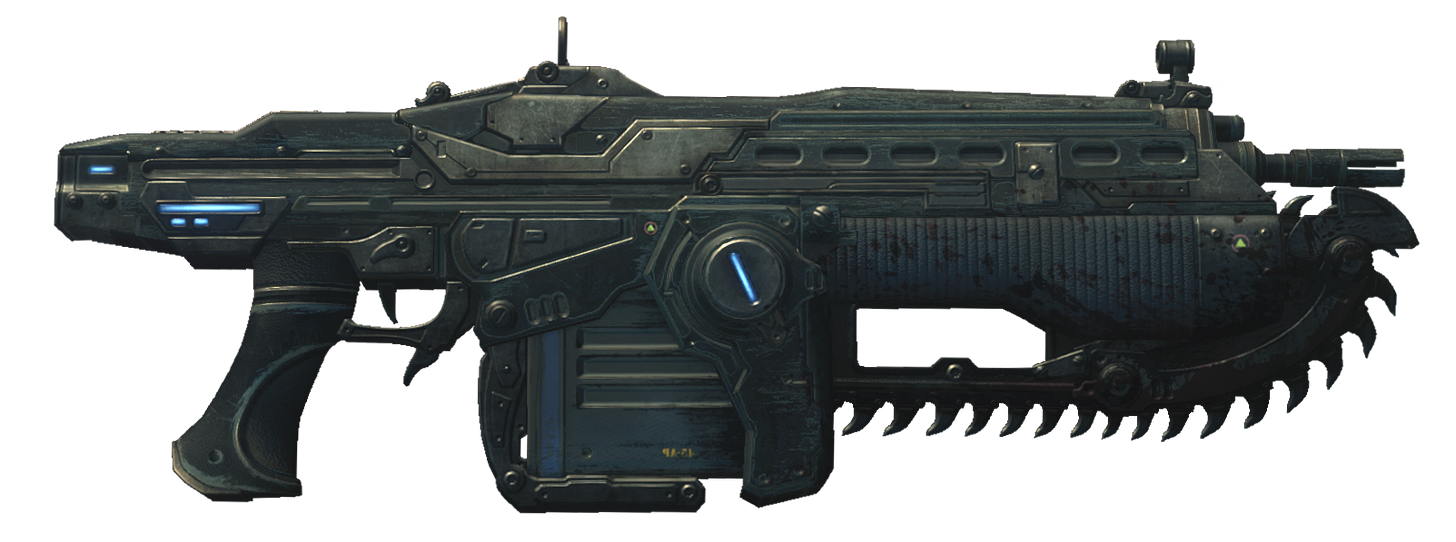Retro Spotlight: Gears of War
Can a game that kicked off a franchise that's spanned 15 years and sold well over 30 million copies be underrated?
This column is “Retro spotlight,” which exists mostly so I can write about whatever game I feel like even if it doesn’t fit into one of the other topics you find in this newsletter. Previous entries in this series can be found through this link.
It feels sometimes as if the attitude around Gears of War is that it is a game for meatheads, which probably has something to do with the fact that it stars men who are more meat than man and was conceived by someone who appears to be more bro than anything else, Cliff Bleszinski. Bro culture aside, Bleszinski and the team at Epic had a fantastic idea for moving the third-person shooter genre forward back in the mid-aughts, and the result was 2006’s Xbox 360 exclusive, Gears of War. A third-person shooter, focused heavily on working in and out of cover, moving from point to point to progress. Horror elements were sprinkled in, and a devotion to creating a tense, claustrophobic atmosphere and mood that would serve the game well whether you were throwing grenades at a swarm of foes, or tiptoeing around an unstoppable beast that tracks you by sound, made it more than your typical shooter.
While the series has made some tremendous strides forward since — Gears of War 2 might be one of the best feeling third-person shooters ever, thanks to a series of tweaks and refinements to the original formula, as well as the introduction of new weapons, foes, and the experience that already comes with having made one of these games — the original is still an enjoyable thrill ride that takes place over about 24 hours. You might remember a similar setup from the likes of Resident Evil games, which is not a coincidence: Epic might have focused much more on the action portion of things than even Resident Evil 4 did, but as far as mood and ambiance goes, Gears feels extremely Resident Evil-like. Hell, Resident Evil 5’s further inroads into action — and the bulked up redesign of Chris Redfield, as well as the control scheme that handled him — were heavily influenced by Gears. Insert joke about Ouroboros here.
While the game’s mood, as evidenced by both the music and the way sound and silence are utilized to achieve maximum tension, clearly has its roots in Capcom’s more action-oriented Resident Evil title, it was a game by another Japanese developer that further inspired Epic in their creation of Gears of War. Namco’s 2004 third-person shooter, Kill.Switch, received pretty standard reviews at the time of its release, but it featured a cover system that was more front-and-center than cover had been in a third-person shooter to that point. Gears took it all a step further, and thanks to its excellent weapons, tense and moody design, and a campaign that was worth the price of admission even if you never touched the online multiplayer, ended up being the launching point for a core Microsoft franchise instead of a mostly forgotten one-off.
Gears of War opens with the character you’ll control, Marcus Fenix, being released from prison. There aren’t very many soldiers left to fight a war that’s been ongoing for 14 years, so Fenix, and the rest of the prisoners there, have all been pardoned — and conscripted. Fenix ends up in charge of the squadron he’s a part of after an extremely large Locust — that’s the name of the foe you’re fighting in this war, an enemy force that exploded from the planet’s surface over a decade ago and hasn’t stopped crawling out since… think orcs with assault rifles — snaps the neck of his commanding officer mid-mission. From there, it’s a race against the clock to map out the tunnels of the Locust, so that you can fire off a massive missile that is itself made up of a lot of smaller missiles into the heart of the planet, in the hopes of eradicating the Locust threat.
Yes, some of Gears’ dialogue is goofy, action-movie schlock, but just like with action movies, with the right people delivering those lines you don’t even care. Think, you know, Nicolas Cage’s whole thing in the 90s. In Gears, John DiMaggio is the voice of Marcus Fenix: you might know him from his roles as Futurama’s Bender, or Jake the Dog from Adventure Time, or any number of other characters from the past couple of decades. Every line he delivers, snarls, growls, resignedly utters, whatever, might as well be poetry coming from him. You needed someone like DiMaggio to ensure that that this exchange, while descending into a Locust hive…
Dominic Santiago: "You think they know what we’re doing?"
Marcus Fenix: "Well, we’re not here to sell cookies. So they know something’s up.
…lands rather than falls completely flat, as it probably did when you just read it yourself. It’s the way he delivers the goofy-ass line that does it, and really, Gears is just full of lines like this. By this point in the game, you should be pretty in-tune with Fenix’s whole deal, and so, the line kills me every time.
It’s really a fantastic exercise in voice work, one that helps appropriately set whatever mood you’re supposed to be feeling at that particular moment in time. DiMaggio’s work in these first three Gears’ games is good enough, in fact, that Gears of War 4 — which featured an all-new cast of main characters, and released around the same time as the Gears of War remaster on the Xbox One — is hurt by his absence as a primary player. Everyone sounds like they’re making quips in a Marvel movie or auditioning for a new Uncharted in that game, and while it’s not a poorly written title by any means, it does suffer for trying to cater to that specific moment in time. DiMaggio’s Fenix, however, feels more timeless: his attitude and lines are not of 2006, it’s just DiMaggio’s star turn as an action hero, and a fully believable, layered one, with a shocking amount of depth considering the aforementioned meathead-ed-ness attributed to Gears.
Fenix isn’t the only entertaining character in the game, of course. The whole primary cast of characters is enjoyable for their own reasons, though, Dominic Santiago would get more of a chance to shine in the sequel, as this is clearly the Marcus Fenix show this time around. Still, the non-playable characters in your party — Damon Baird and Augustus Cole — are also played excellently. Baird works here because he’s the only snarky, smarter-than-you character in the bunch, instead of there being an entire cast of them. And Cole, well, my wife and I still quote Cole lines sometimes, because how could you not? “The Cole train runs on whole grain, baby” might not be in this particular Gears title, but he’s still highly entertaining.
The world of Gears feels convincingly lived in from the start. There is very little exposition to explain what’s going on in the game at the time Fenix is released from prison and rejoins the military: you can see with your own eyes the state of things. Buildings half-destroyed, streets rearranged for a version of trench warfare, corpses everywhere, cars left in the road. Nearly everything abandoned, whether valuable or ordinary, the Locust clearly with the upper hand in every way. Between the visuals, the voice work, and the game’s use of sound and music to establish mood, you know exactly what you’re supposed to be thinking and feeling in nearly every moment during the game. It’s all just so well-established and convincing: Gears thrived in large part due to its more gameplay-centered technical decisions, but the environmental, mood-setting half of the game is just as vital to its success, and is a significant part of what made me care about yet another shooter at a time when the world was as lousy with them as Gears’ world was with Locust.
Let’s talk about that gameplay. The emphasis on cover, on making Gears something of a point-to-point game of progression by way of shooting mechanics, has historically gotten the attention, and it is merited. Gears never feels like a slog: you are constantly challenged, constantly made to feel uneasy in one way or another, and it keeps everything chugging along even as another emergence hole opens up in the ground, spilling Locust into your midst once more. However, it’s the combination of extremely active gameplay with this methodical progression that causes the whole endeavor to work the way it does. Active, yet methodical. That’s how Gears works.
The methodical nature is in how you are constantly finding cover to hide behind, in order to clear the room, street, whatever of Locust, and making it safe to progress to the next point where you will likely do the whole thing again. It’s far more than just siting behind cover waiting for a head to pop out, though. You’re going to be active: you’ll be constantly running around, low to the ground, to find an improved piece of cover. You’ll have to exit cover in order to deal with the Locust who have run around to flank you, which will happen often enough to instill a permanent sense of foreboding in your every action. You’ll find yourself being the one doing the flanking, leaving the safety of cover to come at enemies from behind, or to throw yourself in the middle of everyone’s line of sight in order to draw attention and break through a defensive line that simply will not crumble while you sit behind a wall.
The weapon that will make this particular strategy effective is, more often than not, the Lancer. This is normally just an assault rifle with a sizable magazine, but its secondary fire is a chainsaw bayonet. Yes, there is a chainsaw attached to this rifle, and you can use it to chainsaw through Locust. While the iffiest version of this gun exists within the original Gears of War — and its iffiness was not tuned up in the 2015 remaster — it’s still a fantastic addition to the experience. It’s a little touchy here, is all, and doesn’t always rev up when you want it to, which can mean you have now left yourself out in the open, susceptible to a melee attack or a shotgun blast to the face from your opponent you were just trying to cut into ribbons. So, you’ll have to be very careful, especially on the Hardcore or Insane levels of difficulty, about when you deploy this particular weapon. But man, it remains as impressive and useful as it is gory and depraved, and it’s a tribute to the rest of the world-building and immersion going on here that you feel good using this thing instead of disgusted with the idea of it.

There’s the act of reloading itself that’s active: in Gears, you don’t simply reload your gun with a button press. You begin a reloading process, and if you time a second button press correctly, you’ll reload faster, and also deliver more damage per shot with the new magazine. Active reloading is a tremendous addition to shooters, and it can be the difference between winning and losing a firefight. If you mistime your active reload, it will take you longer to reload, and you might very well be killed as your character fumbles with their gun. If you successfully do a perfect active reload, however, that next headshot might be the only one you need to make: especially if you and your foe have to reload at the same time, and you finish your process first.
The active reload process has slightly different timing for each weapon, and chances are good you will familiarize yourself with the vast majority of Gears’ arsenal during your playthrough of its five acts. Aside from the Hammerburst assault rifle, which is a pretty vanilla gun that you begin the game with and will discard whenever you get the chance, Gears is full of fascinating, powerful weapons. The Lancer doesn’t just have a chainsaw, but is also an accurate, from distance, assault rifle that will let you slow down and kill Locust whether you’re aiming for their heads or filling up that bullet sponge until it cannot be filled anymore. The shotgun has limited range, accuracy-wise, but you’ll realize soon that it’s one of the most powerful weapons in the game up close, whether you fire it or simply swing it at a foe. There is nothing particularly special about the Longshot sniper rifle, other than that it does its job well, but the true king of the sniping in this game is the Torque Bow, which is a mechanized bow-and-arrow, where the arrows have explosive tips. You basically charge it up before firing, creating more torque, and after a certain point it is able to embed itself even in enemy armor. Locust might be powerful, but they’re usually not “survive an explosive arrow that’s embedded in their chest before it blows” powerful.
There is just one grenade type in this first Gears, the frag grenade, but it’s a surprisingly versatile weapon because of how it can be used. You can throw it by aiming it at an arc, which will show up on screen. This can be useful for accuracy’s sake, but is dangerous, because you must stick your head out of cover to do this aiming. You can blind throw it instead, which I cannot recommend enough you learn how to do: you can no-look throw a grenade a considerable distance, and with considerable accuracy, with enough practice. I can hit targets I know are there that I can’t see throwing grenades this way at this point, which is terrifying, hilarious, and most importantly, effective. You can also tag enemies with a grenade: use a frag grenade as a melee weapon, and then quickly get some distance between you and the tagged, because they’re going to explode in a few seconds.
Grenades can be used to flush Locust out of cover, to close up their emergence holes quickly — the usual method for closing a hole is to defeat every Locust that is coming out of it, but it is much faster to just toss a grenade right into it as soon as it opens — or for the old-fashioned purpose of blowing up a target. That you can use them in so many different ways to accomplish these tasks make them some of the best grenades going, even though they’re “just” frag grenades. And this kind of thoughtfulness applies across the weaponry in Gears: less so in this first game, before even further innovation occurred, but still, in high enough quantities even here that it’s noticeable.
As said before, Gears 2 is where the game feels incredible to play, but its predecessor certainly doesn’t feel bad to play. The cover system isn’t quite as reliable from a getting into and out of perspective, and you aren’t going to want to be quite as chainsaw-focused here as you can be in later Gears titles, but if you play it the way it was intended, and can deal with the occasional moment where it feels like your character is doing something different than what you told them to do, you’re going to have a good time. Checkpoints are generally pretty generous — there are a few points you will die in that you wish you had not, when the checkpoints aren’t quite as giving, but overall, you won’t have to replay much to move forward, and you can skip cutscenes, too, should you not want to watch them a second (or third, or fourth, or however many times, if you’re playing on the tougher difficulties).

The only real complaint I have about Gears other than these little frustrations that were smoothed over in later titles is the inclusion of vehicles and sections where you have to use turrets. It is so very 2006 of the game — any game from then — to force vehicle and turret sections in, and they weren’t very fun at the moment, and are less fun now. The vehicle section in question here isn’t so bad if you’re playing co-op, since the truck in question has a ultraviolet turret manned by one player and the actual driving is controlled by the other, but solo, it can be annoying to have to maneuver the turret around to see if the Krill — think bloodthirsty bird-bats that will kill you almost instantaneously if they find you in the dark — are coming up behind you or from the side while you’re trying to drive a road full of roadblocks. The turret bits are thankfully even shorter, but on higher difficulties, incredibly frustrating to play solo as you’re being attacked by powerful flying foes on both sides of a train car, with turrets that won’t reach each side on their own. You will probably be killed if you’re playing solo, again and again, and while you can figure out the rhythm of it all, it’s not an enjoyable discovery like it can be elsewhere. It’s just frustrating, and unnecessary, especially so close to the last boss fight.
That’s very little to complain about in a 10-hours-or-so campaign, however. Epic delivered a game so well realized and full of depth that you wouldn’t know just by playing that it’s the first in the series, unless you were already familiar with the improvements from future installments that are missing here.
I, oddly enough, have more issues with the remastered Ultimate Edition on the Xbox One than with the original. I wish they had tweaked the touchiness of the chainsaw bayonet so it felt more in line with the rest of Gears, but even that personal quibble aside, there are problems. The characters are no longer allowed to be “ugly,” which is a shame, and part of a larger (and annoying) trend in games over the last couple of generations. Gears’ characters were, by and large, heavily scarred, pockmarked, as beaten up in appearance as the world they lived in. Dominic Santiago now has a full, thick beard, with longer hair on the top of his head, too, and all of the scarring and damage to his face that a decade-plus of constant war brought was removed for the remaster. Fenix’s lengthy face scar remains, but overall, the character models were all brought out of a past where they were allowed to be marked by their experiences into one where they’re fresh-faced with clear pores even though they’re 14 years into a war against creatures that erupt from the Earth and explode viscera in every direction when killed.

The Xbox One remaster is also a buggier game than the original, which feels pretty unforgivable, especially in conjunction with the fact it feels as if your partner AI is worse than it was in a game released back in 2006. Luckily, I didn’t encounter any game-breaking bugs, but there were an alarming number of instances where I would watch a teammate chainsaw a Locust, only for the game to act as if it was my partner that had been chainsawed, trapping them in a death animation that would linger until the area had been cleared.
This would have been tougher to deal with if for not the fact that it mostly felt like I was playing by myself throughout the remastered edition of Gears of War. I was pretty used to my teammates being useless in a way I don’t recall them being in the original release on the Xbox 360, so them being knocked out of commission by a bug was just a more honest version of their uselessness. I say “I don’t recall” the AI being this bad, and I don’t mean that in a “from when I played in 2006” sense. I’ve replayed the original Gears quite a few times since then, including just last year on an attempt to complete the game on Insanity, so my memory is pretty fresh on this particular point. Gears’ AI was also worse in Gears 5 than you would have imagined it would be at this point in the series’ history, so maybe it’s just that the teams handling Gears these days aren’t quite as good at programming AI as Epic was.
All that being said, if the only version of Gears of War you can get your hands on is the Ultimate Edition, then it’s still worth it. It’s just odd that they managed to improve the game in some respects and make it worse at the same time. Gears of War, like the rest of the series, is playable on an Xbox One and Series X/S, in either Xbox 360 disc form, or through Game Pass at present. If you’ve never taken control of Marcus Fenix to stop the Locust horde before, well, it’s still worth doing 15 years later. And if it’s simply been awhile, and you’ve got the itch to attempt it on Insane like this guy right here, then you have my recommendation and my best wishes.
This newsletter is free for anyone to read, but if you’d like to support my ability to continue writing, you can become a Patreon supporter.





